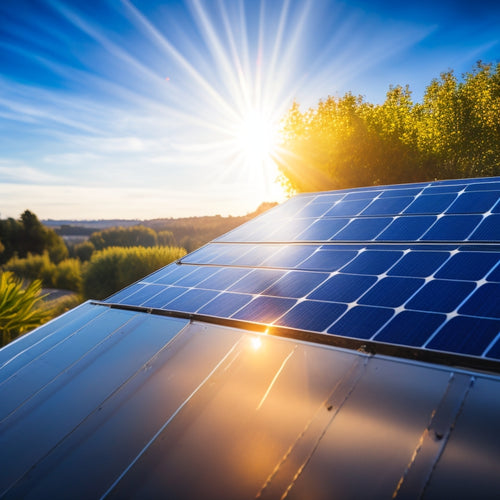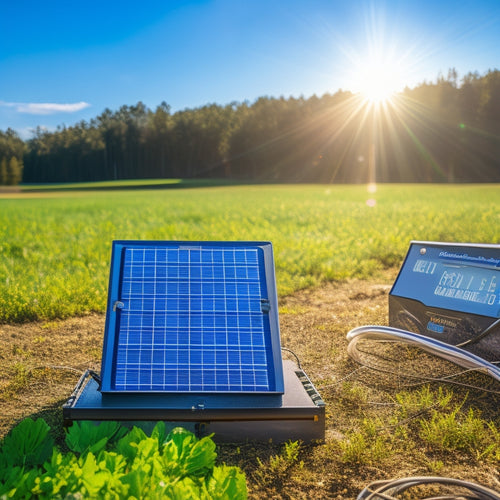
7 Tips for Portable Energy Freedom
Share
To achieve portable energy freedom, you'll need to assess your energy needs, choosing the right solar panels, optimizing your energy storage, and selecting the perfect inverter. Consider portable power solutions like compact batteries and mobile solar solutions for on-the-go energy. Implement remote monitoring and control to track your energy consumption and receive alerts for unusual spikes in usage. As you build your system, prioritize compatibility, efficiency, and durability to guarantee a reliable and customizable power setup. By following these tips and staying informed on the latest energy technologies, you'll be well on your way to revealing true energy independence - and there's even more to uncover ahead.
Overview
- Assess energy consumption patterns to determine power generation requirements and optimize energy usage.
- Select high-efficiency solar panels with ratings above 20% and consider temperature coefficient and durability for optimal performance.
- Implement energy storage management strategies, such as limiting charge cycles and maintaining a depth of discharge of 50% or less, to prolong battery lifespan.
- Choose the right inverter based on device power requirements and ensure compatibility with the energy storage system for reliable supply.
- Utilize remote monitoring and control to track energy consumption patterns and receive alerts for anomalies or malfunctions for prompt corrective action.
Assess Your Energy Needs
With portable energy freedom on your mind, reviewing your energy needs is the critical first step towards achieving it. You must identify your energy consumption patterns to determine the right amount of power you need to generate.
Take stock of your lifestyle habits, including the devices you use, their wattage, and the frequency of use. Calculate your daily energy consumption by multiplying the wattage of each device by the number of hours you use it. This will give you a clear depiction of your energy requirements.
Don't forget to create an energy profile listing device power ratings and daily usage hours, and consider device efficiency and potential system losses in calculations. Be honest with yourself, and don't forget to factor in any future energy needs.
Choose the Right Solar Panels
When selecting solar panels for portable energy freedom, you'll need to take into account a few key factors.
You've already assessed your energy needs, so now it's time to compare panel efficiency to guarantee you're getting the most power from your setup. High-efficiency solar panels with ratings above 20% can greatly maximize energy output, and researching manufacturer reputation and customer reviews can provide confidence of reliability independent testing organizations.
Assess Your Energy Needs
Your energy needs dictate the size and type of solar panel system required to power your devices, so it's vital to assess them accurately. To do this, track your energy consumption over a week or month to get a clear illustration of your daily usage patterns.
Consider your lifestyle impact, including the number of devices you need to power, their individual energy requirements, and your mobility needs. Will you be stationary or on-the-go? Do you need to power a laptop, lights, or a fridge?
When selecting solar panels, look for efficiency ratings above 20% to maximize energy generation per sunlight hour. By understanding your energy needs, you can determine the right solar panel system to provide you with the freedom to generate power anywhere, anytime.
This includes selecting the correct panel size, voltage, and capacity to meet your specific requirements.
Compare Panel Efficiency
Selecting the right solar panels is vital to achieving portable energy freedom, and it all starts with comparing panel efficiency.
You'll want to research and compare the efficiency of different solar panel types, including monocrystalline, polycrystalline, and thin-film panels. Efficiency comparison is important, as it affects how much energy you can generate per hour of sunlight.
Look for panels with high efficiency ratings, typically above 20%. Consider factors like temperature coefficient, which affects performance in hot climates, and durability, which impacts long-term energy output.
Select the Right Size
A few high-quality solar panels can be more effective than a larger number of low-performing ones, so it's important to choose the right size for your portable energy needs.
When selecting the right size, consider your battery capacity and weight considerations. Look for panels with portability features that fit your lifestyle.
You'll also want to evaluate charging options, including USB ports and DC charging. Assess the environmental impact of the panels, as well as the cost analysis and maintenance requirements.
Read user reviews to get a sense of real-world performance. By choosing the right size, you'll strike a balance between energy output and portability, ensuring you have the freedom to take your energy on the go.
Optimize Your Energy Storage
Every critical component of your portable energy system relies on efficient energy storage. You should prioritize energy conservation and battery maintenance to guarantee maximum performance and longevity. Here's a breakdown of key considerations for optimizing your energy storage:
| Factor | Impact | Recommendation |
|---|---|---|
| Depth of Discharge (DOD) | Affects battery lifespan | Aim for 50% DOD or less |
| Charge Cycles | Influences battery health | Limit charge cycles to 300-500 |
| Temperature | Impacts battery performance | Store batteries between 60°F-80°F (15°C-27°C) |
| Monitoring | Helps prevent overcharge/undercharge | Use a battery management system (BMS) |
Select the Perfect Inverter
Your optimized energy storage system is now ready to power your devices, but it's only half the battle. You still need an inverter to convert the stored energy into usable AC power.
Choosing the right inverter is vital to guarantee efficient and reliable energy supply. You'll need to take into account the type of inverter that suits your needs, such as pure sine wave, modified sine wave, or square wave inverters.
Research reputable inverter brands like Renogy, Goal Zero, or Suaoki, and compare their features, efficiency, and durability. Reflect on factors like power output, surge capacity, and noise level to select the perfect inverter for your portable energy system.
Portable Power on the Go
Freedom to roam comes with the convenience of portable power on the go. You can investigate outdoor excursions without worrying about running out of juice. With portable chargers, compact batteries, and mobile solar solutions, you're guaranteed energy independence. Whether you're a traveler, an outdoor enthusiast, or someone who wants to be prepared for emergencies, these travel gadgets are a must-have.
| Travel Gadget | Key Features |
|---|---|
| Portable Chargers | Compact, lightweight, and fast charging |
| Compact Batteries | High-capacity, eco-friendly, and durable |
| Mobile Solar Solutions | Waterproof, foldable, and high-efficiency |
| Solar Backpacks | Integrated solar panels and storage |
| Emergency Power Kits | All-in-one kits for disaster preparedness |
Monitor and Control Remotely
You can guarantee maximum energy freedom by monitoring and controlling your portable energy system remotely.
This allows you to receive real-time system updates, so you're always aware of your system's status.
Real-time System Updates
Through remote monitoring, real-time system updates enable users to stay informed about their portable energy setup's performance, no matter the location.
You'll receive real-time monitoring data on your system's status, allowing you to identify potential issues before they become major problems.
System alerts will notify you of any anomalies or malfunctions, giving you the freedom to take corrective action promptly.
With real-time system updates, you can rest assured that your portable energy setup is running smoothly and efficiently.
This feature provides you with complete control and peace of mind, even when you're not physically present.
Energy Usage Tracking
Real-time system updates provide a solid foundation for efficient portable energy management, and energy usage tracking takes it a step further by giving you a precise depiction of your energy consumption patterns. With energy usage tracking, you can monitor and control your energy consumption remotely, making adjustments as needed to optimize your energy usage.
| Feature | Benefit | Description |
|---|---|---|
| Real-time Monitoring | Identify energy waste | Track energy consumption in real-time to detect areas of inefficiency |
| Historical Data Analysis | Optimize energy usage | Analyze past energy consumption patterns to optimize your energy usage |
| Customizable Alerts | Stay informed | Receive alerts when energy consumption exceeds set thresholds |
| Energy Consumption Analysis | Make data-driven decisions | Get detailed observations into your energy consumption patterns to make informed decisions |
Expand Your Energy System
As your energy needs evolve, incorporating additional power sources and storage capacity into your existing setup becomes vital.
You'll need to assess your energy budgeting to determine the best way to expand your system. Consider integrating renewable sources, such as solar or wind power, to reduce your environmental impact.
When selecting new battery technologies, prioritize efficiency upgrades and compatibility with your existing system. Follow a thorough installation guide to guarantee seamless system integration.
Regular maintenance tips, like monitoring performance and updating software, will help prevent downtime.
Frequently Asked Questions
Can I Use a Portable Energy System for My Home?
You're wondering if you can utilize a portable energy system to power your home energy needs. The answer is yes, you can, using portable systems designed for residential use, providing independence and flexibility in your energy consumption.
How Long Does It Take to Charge My Devices?
When you're on-the-go, you wonder how long it takes to charge your devices. Investigating charging speeds, you'll find it depends on device compatibility and power output, with fast-charging tech like USB-C and QuickCharge replenishing batteries rapidly, while standard USB-A takes longer.
Can I Use Multiple Energy Sources at Once?
You can utilize multiple sources simultaneously, enhancing energy efficiency; for instance, you're able to charge your device via solar panel and battery pack at the same time, maximizing power output and reducing downtime.
Are Portable Energy Systems Environmentally Friendly?
You're wondering if portable energy systems are environmentally friendly? Imagine a unicorn-powered generator (just kidding, that's not a thing... or is it?). Seriously, you'll be happy to know that many portable systems offer sustainability benefits and renewable options, reducing your carbon footprint.
Do I Need a Technical Background to Set It Up?
You don't need a technical background to set up a portable energy system; most manufacturers prioritize setup simplicity, providing thorough user manuals that guide you through the process, ensuring a smooth and hassle-free experience.
Ready to Buy
You've taken the first step towards portable energy freedom. Now, go ahead and unplug from the grid! With these 7 tips, you're equipped to utilize the sun's power and take control of your energy needs. Remember, energy independence is not just a luxury, it's a necessity. Don't be held hostage by utility bills - break free and strengthen your lifestyle.
Related Posts
-

Why Outdoor Solar Lighting Systems Are Sustainable
Outdoor solar lighting systems are sustainable because they utilize renewable energy, drastically reducing your carbo...
-

How Efficient Are Thin Film Solar Cells
Thin film solar cells provide an innovative approach to energy generation, boasting efficiency rates generally betwee...
-

Choosing the Right Solar Power Charge Controller
Choosing the right solar power charge controller is crucial for maximizing energy efficiency and extending battery li...


